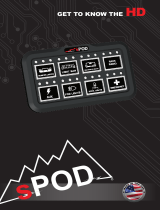
8 Section 61104020L4-5, Issue 3 61104020L4-5C
The front panel bantam jacks accommodate standard
DS0 Logic Testers such as the TPI 108/109 RT II or
FIREBERD 4000/6000 which perform both the
upstream and downstream testing.
NOTE
On DDS circuits the internal 2047 Pattern
Generator on the U-BR1TE V should be used
only when the service is operating at 64 kbps. If
DDS service is operating at 56 kbps or less, the
U-BR1TE V will display errors if the internal
2047 Pattern Generator is used. The use of
external DDS test equipment is required for all
data rates at 56 kbps and below.
Loopback Tests (ADR1 - ADR6, NT1)
Loopbacks in the Network-to-Customer direction can
be initiated from either the ISDN switch or the front
panel. Either the internal 2047 test pattern or a DS0
digital test set provide the 64 kbps test pattern to be
tested in B1 or B2. When initiating loopbacks from
the U-BR1TE V front panel, the downstream direction
is automatically selected based on the card position in
the network.
To initiate a loopback using the internal 2047 test
pattern, perform the following:
1. Select the desired loopback address using the ten-
position rotary switch. See Table 2.
2. Select the desired bearer channel using the B1/B2
DIP switch.
3. Select PTRN on the NORM/PTRN DIP switch.
4. Depress the recessed TEST pushbutton to initiate
the test. The TEST LED will illuminate GREEN
when the loopback is established to the selected
address, and the ERR LED should go out
following synchronization to the test pattern. If
the selected address does not respond, the TEST
LED will remain out and the ERR LED will
illuminate.
5. To insert one bit error, momentarily (for less
than two seconds) depress the TEST pushbutton.
The ERR LED should flash upon receipt of the
injected error.
6. Tests to additional network addresses may be
performed by changing the selector knob to the
desired address. It is not necessary to exit the test
mode to select a new address.
7. To deactivate the loopback, depress the TEST
pushbutton for two seconds, until the GREEN
TEST LED is extinguished, or select NORM on
the NORM/PTRN DIP switch.
To initiate a loopback at any data rate when using an
external DS0 digital test set, perform the following:
1. Insert the TX and RX bantam plug of the DS0
digital test set into the U-BR1TE V respective
front panel bantam jacks. Connect the clock
input of the DS0 digital test set to the channel
bank’s clock source (the D4 OIU, or the SLC-96
SSU). Configure the test set for Near Logic and
64 kbps.
2. Select the desired loopback address using the ten-
position rotary switch. See Table 2.
3. Select the desired bearer channel using the B1/B2
DIP switch.
4. Depress the recessed TEST pushbutton to initiate
the test. The TEST LED will illuminate
YELLOW when the loopback is established to
the selected address. If the selected address does
not respond, the TEST LED will remain off.
Observe the DS0 digital test set for bit errors.
5. Tests to additional network addresses may be
performed by changing the selector knob to the
desired address. It is not necessary to exit the test
mode to select a new address.
6. To deactivate the loopback, depress the TEST
pushbutton or remove the transmit bantam plug.
Upon deactivation of the test, the TEST LED will
go out.
Point-to-Point Test (CRTX, LPTX)
A point-to-point (straight-away) test can be performed
to either the U-interface (LPTX) or the T-1 carrier
interface (CRTX). In both cases, either the internal
2047 test pattern generator or a DS0 DP digital test set
is used to verify the performance of the selected
bearer channel.
To initiate a point-to-point test using the internal 2047
test pattern, perform the following:
1. Select the desired test direction, LPTX or CRTX,
using the ten-position rotary switch. See Table 2.
2. Select the desired bearer channel using the B1/B2
DIP switch.
3. Select PTRN on the NORM/PTRN DIP switch.
















